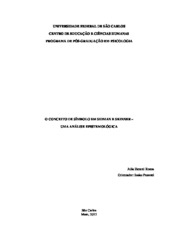| dc.contributor.author | Rocca, Julia Zanetti | |
| dc.date.accessioned | 2016-06-02T20:30:07Z | |
| dc.date.available | 2012-12-21 | |
| dc.date.available | 2016-06-02T20:30:07Z | |
| dc.date.issued | 2012-06-04 | |
| dc.identifier.citation | ROCCA, Julia Zanetti. The concept of symbol in Sidman and Skinner - An epistemological
analysis. 2012. 212 f. Tese (Doutorado em Ciências Humanas) - Universidade Federal de São Carlos, São Carlos, 2012. | por |
| dc.identifier.uri | https://repositorio.ufscar.br/handle/ufscar/5979 | |
| dc.description.abstract | The theory of language created by Skinner in the 1950s rejected traditional terms such as reference , meaning and symbol , due to considering such terms useless and inadequate to a science of verbal behavior. Still, since the 1960s new theories of language in behavioral analysis have come to make use of these terms both to describe phenomena and to define concepts. In order to investigate this theoretical dissonance, the present work analyses the concepts of reference , meaning and symbol in the theories of Skinner and Sidman. In regards to Skinner, the investigation has implied in (I) the analysis of the theories of language that have exerted influence on his work in order to understand the rejection of both reference and symbolism; (II) the description of the theoretical path of construction of a science of verbal behavior through an operationalist conception of language. In the case of Sidman, the theory of language arises as a result of experimental discoveries, which by its turn demanded from the conceptual investigation: (I) the description of the origin of the technical terms used in the field through Sidman s and his predecessor s researches; (II) the analysis of potential theoretical influences upon conceptual formalization of the stimulus equivalence paradigm. As the result, it has been verified that the theories of both Sidman and Skinner share the influence of the logical branch of the Philosophy of Language, and especially of the Logical Positivists. However, while Sidman s work is close to these philosopher s initial theories, Skinner s work is characterized as critical in relation to them. Moreover, the epistemological analysis of the stimulus equivalence paradigm has allowed the conclusion that this model adopts strictly operationalist presuppositions, and beyond that, of an Skinnerian Operationalism that is to say, different both from Bridgman s original version and from other psychological versions, such as Stevens . And since Operationalism would be the most important basis for the analysis of language proposed by Skinner, the conceptual differences between the theories of Sidman and Skinner appear to coexist with a confluence in their epistemological foundations. | eng |
| dc.description.sponsorship | Universidade Federal de Minas Gerais | |
| dc.format | application/pdf | por |
| dc.language | por | por |
| dc.publisher | Universidade Federal de São Carlos | por |
| dc.rights | Acesso Aberto | por |
| dc.subject | Psicologia - filosofia | por |
| dc.subject | Significado | por |
| dc.subject | Referência (Filosofia) | por |
| dc.subject | Comportamento verbal | por |
| dc.subject | Equivalência de estímulos | por |
| dc.subject | Símbolo | por |
| dc.subject | Meaning | eng |
| dc.subject | Rference | eng |
| dc.subject | Symbol | eng |
| dc.subject | Verbal behavior | eng |
| dc.title | O conceito de símbolo em Sidman e Skinner - uma análise epistemológica | por |
| dc.title.alternative | The concept of symbol in Sidman and Skinner - an epistemological
analysis | eng |
| dc.type | Tese | por |
| dc.contributor.advisor1 | Pessotti, Isaias | |
| dc.contributor.advisor1Lattes | http://lattes.cnpq.br/2793069740146109 | por |
| dc.description.resumo | A teoria da linguagem criada por Skinner na década de 50 rejeitava termos tradicionais como referência , significado e símbolo por considera-los inúteis e inadequados em uma ciência do comportamento verbal. Apesar disso, a partir da década de 60, novas teorias da linguagem na análise do comportamento passaram a utilizar esses termos tanto para descrever fenômenos quanto para definir conceitos. Para investigar essa dissonância teórica, o presente trabalho analisa os conceitos de referência , significado e símbolo nas teorias de Skinner e de Sidman. Em relação a Skinner, o trabalho implicou em (I) análise das teorias da linguagem que influenciaram seu trabalho para compreender a rejeição da referência e do simbolismo; (II) descrição do percurso teórico de construção de uma ciência do comportamento verbal a partir de uma concepção operacionista da linguagem. No caso de Sidman, a teoria da linguagem aparece como um resultado de descobertas experimentais, então, a investigação conceitual exigiu: (I) descrição da origem dos termos técnicos da área por meio da remissão às pesquisas de Sidman e de seus predecessores; (II) análise de possíveis influências teóricas na formalização conceitual do paradigma de equivalência de estímulos. Como resultado, verificou-se que as teorias de Sidman e Skinner compartilham a influência da vertente lógica da filosofia da linguagem, especialmente referente aos Positivistas Lógicos. Entretanto, o trabalho de Sidman se aproxima das teorias iniciais desses filósofos, enquanto que o de Skinner se caracteriza como uma crítica a estes. Além disso, a análise epistemológica do paradigma de equivalência de estímulos permitiu concluir que esse modelo adota pressupostos estritamente operacionistas e, mais que isso, de um Operacionismo nos moldes skinnerianos (diferente do original de Bridgman e de outras versões psicológicas, como Stevens). Como o Operacionismo seria o fundamento mais importante da análise da linguagem proposta por Skinner, as diferenças conceituais das teorias de Sidman e Skinner parecem conviver com uma confluência em seus fundamentos epistemológicos. | por |
| dc.publisher.country | BR | por |
| dc.publisher.initials | UFSCar | por |
| dc.publisher.program | Programa de Pós-Graduação em Psicologia - PPGPsi | por |
| dc.subject.cnpq | CIENCIAS HUMANAS::PSICOLOGIA | por |
| dc.contributor.authorlattes | http://lattes.cnpq.br/7678523240628345 | por |
